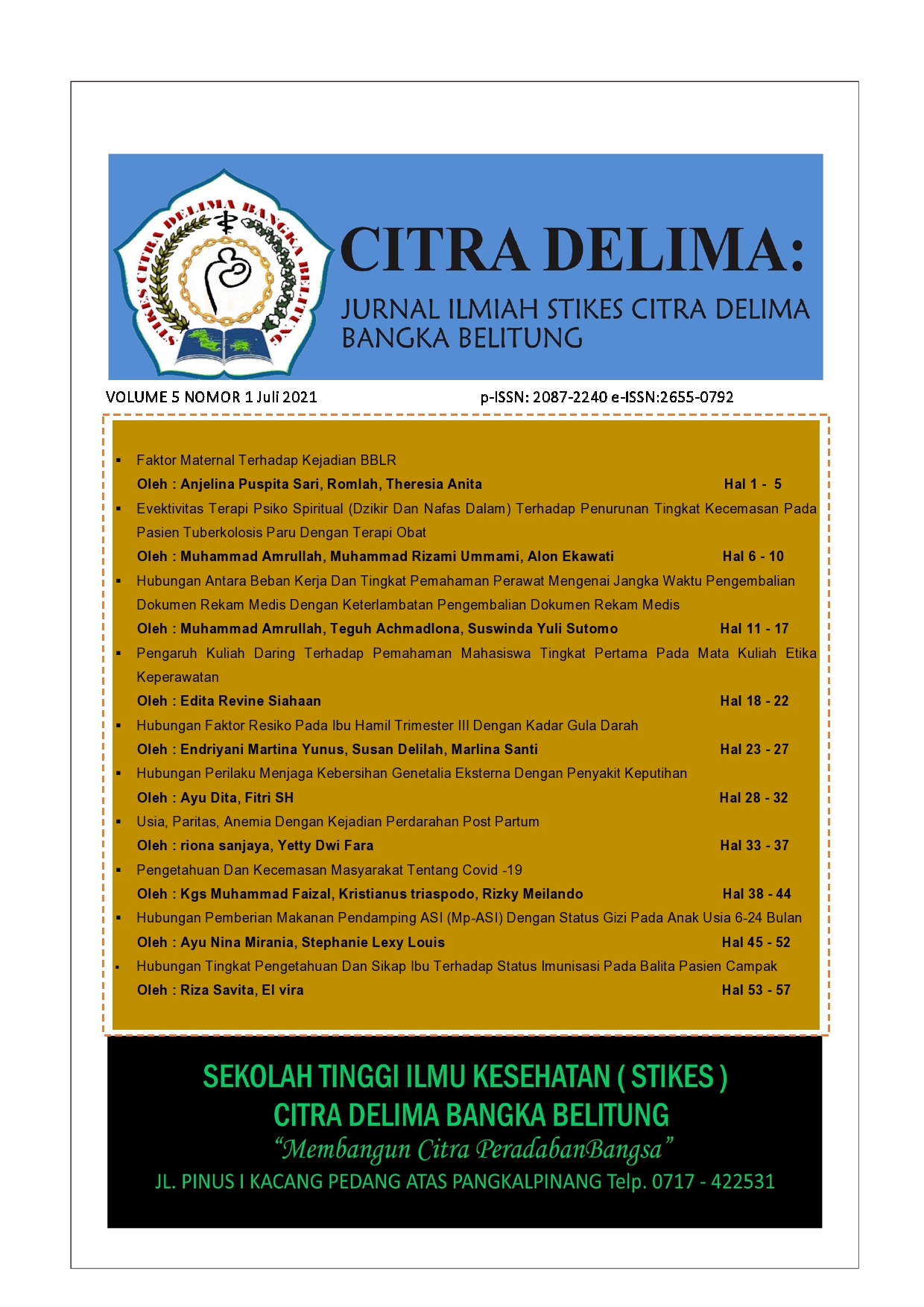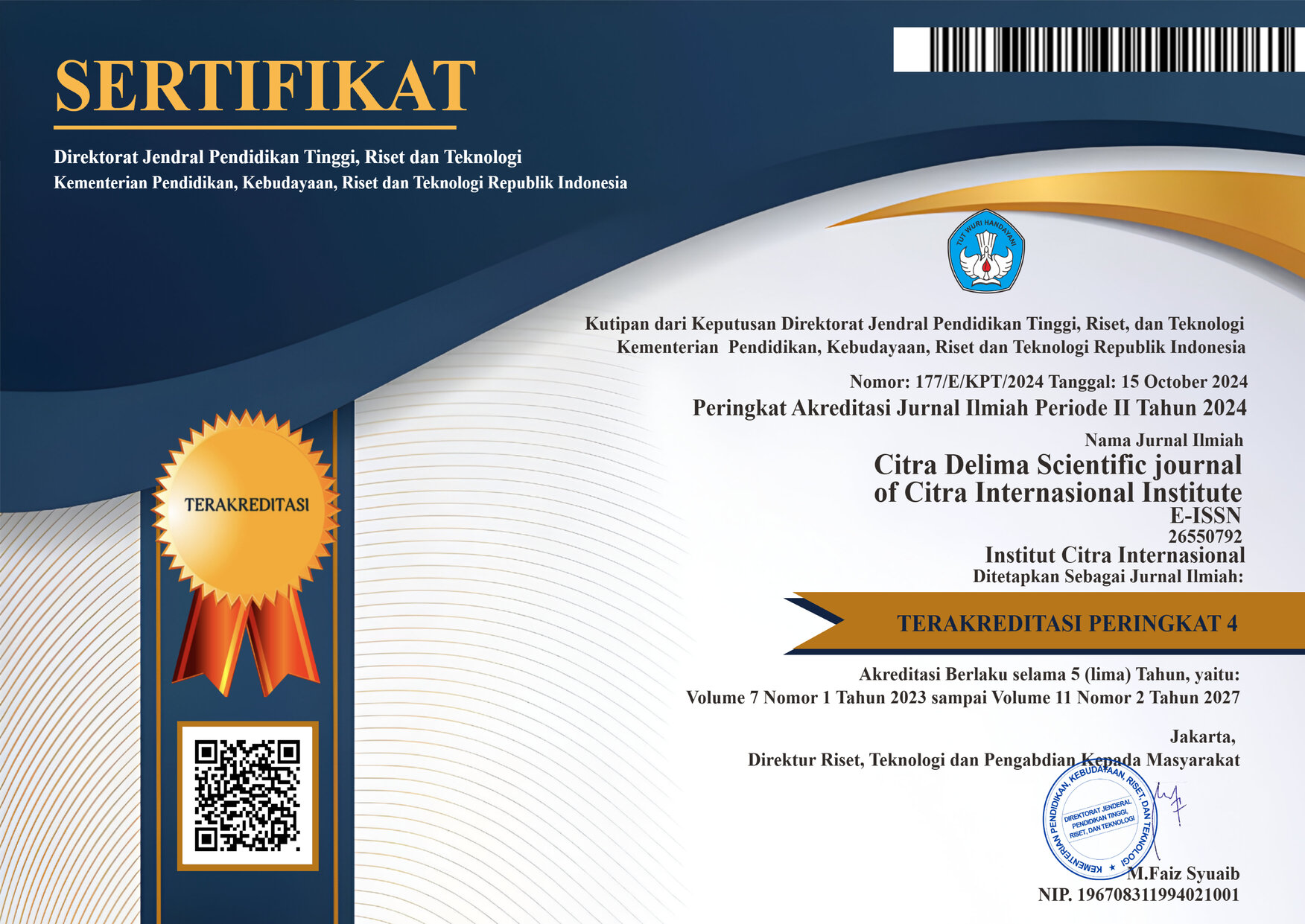Faktor Maternal Terhadap Kejadian BBLR
DOI:
https://doi.org/10.33862/citradelima.v5i1.210Keywords:
Maternal factors, LBWAbstract
Background: Low Birth Weight Infants (LBW) is one of the causes of infant mortality which causes various health problems. Palembang City Health Office in 2017 stated that 29 cases of infant mortality, one of which was LBW. This study aimed to determine the relationship between maternal factors with the incidence of LBW. Methods: This study was an obsevastional with a cross sectional design. This study was conducted from May-September 2019, with a samples was 52 respondents. Samples were collected by observing retrospective data from the respondent's medical records. Data analysis technique was the Chi-Square. Results: The results showed a significant relationship between age and LBW (pv = 0.012), the parity with LBW were significantly related (pv=0.047), and there was no significant relationship the previous LBW history with LBW (pv =0.094). Conclusion: LBW raises various health problems in newborns. Therefore, it requires tighter supervision of pregnant women, especially pregnant women who are included in the risk factors.
Downloads
References
Dinas Kesehatan Kota Palembang. (2018). Profil Kesehatan Tahun 2017. Jakarta : Kementrian Kesehatan RI
Fall CHD., Sachdev SH., Osmond C., Mendez MC., Victora C., Martorell R., et al. (2015). Association between maternal age at childbirth and child and adult outcomes in the offspring: a prospective study in five low-income and middle-income countries (COHORTS collaboration). Lancet Glob Health, 3(7), pp. e366-e377. doi: http://dx.doi.org/10.1016/S2214-109X(15)00038-8
Goisis A., Remes H., Barclay K., Martikainen P., Myrskyla M. ( 2017). Advanced Maternal Age and the Risk of Low Birth Weight and Preterm Delivery: a Within-Family Analysis Using Finnish Population Registers. American Journal of Epidemiology, 186(11), pp. 1219–1226. doi: https://doi.org/10.1093/aje/kwx177
Kementerian Kesehatan RI. 2014. Profil Kesehatan Indonesia Tahun 2013
Kenny LC, Lavender T, McNamee R, O'Neill SM, Mills T, Khashan AS. (2013) Advanced maternal age and adverse pregnancy outcome: evidence from a large contemporary cohort. PLoS One, 8, pp. e56583. doi: https://doi.org/10.1371/journal.pone.0056583
Khoiriah A. (2017). Hubungan Antara Usia dan Paritas Ibu Bersalin dengan Berat Bayi Lahir Rendah (BBLR) di Rumah Sakit Islam Siti Khadijah Palembang. Jurnal Kesehatan 8(2), pp. 310-314
Klemmetti R., Gisler M., Sainio S., Hemminki E. (2013). Associations of maternal age with maternity care use and birth outcomes in primiparous women: a comparison of results in 1991 and 2008 in Finland. Acta Obstet Gynecol Scand 1996;75:19–27. doi: https://doi.org/10.1111/1471-0528.12415
Kusumawati E. (2017). Tinjauan Sistematis Terhadap Faktor Risiko Kejadian Berat Badan Lahir Rendah di Indonesia. Journal of Health Science and Prevention, 1(1), pp. 38-44
Nengsih U, Noviyanti, Djamhuri DS. (2016). Hubungan Riwayat Kelahiran Berat Bayi Lahir Rendah dengan Pertumbuhan Anak Usia Balita. Midwife Journal, 2(02).
Ngowa JDK, Ngassam A, Dohbit JS, Nzedjom C, Kasia JM. (2013) Pregnancy outcome at advanced maternal age in a group of African women in two teaching hospitals in Yaounde, Cameroon. Pan Afr Med J, 14, pp. 134. doi: 10.11604/pamj.2013.14.134.2315
Putri TA., Oviana A., Triveni T. (2018). Hubungan Umur dan Paritas dengan Kejadian Bayi Berat Lahir Rendah (BBLR) di RSUD Solok. Prosiding Seminar Kesehatan Perintis, 1(2).
Romlah dan Sari, APS. (2020). Konsumsi Tablet Fe Terhadap Kadar Hemoglobin Ibu Hamil Trimester II. Jurnal Kesehatan Poltekkes Palembang, 15(1), pp. 45-51.
Salawati L. (2012). Hubungan Usia, Paritas Dan Pekerjaan Ibu Hamil Dengan Bayi Berat Lahir Rendah. Jurnal Kedokteran Syiah Kuala, 12(3). pp: 138-142
Saloojee H., and Coovadia H. (2015). Maternal age matters: for a lifetime, or longer. 3(7), pp. e342-e343. dOI:https://doi.org/10.1016/S2214-109X(15)00034-0
Santri, Ades dkk. (2014). Faktor-faktor Yang Mempengaruhi Pertumbuhan dan Perkembangan Anak Usia Toddler (1-3 tahun) dengan Riwayat Berat Bayi Lahir Rendah (BBLR). Program Studi Ilmu Keperawatan Fakultas Kedokteran Universitas Sriwijaya
Sembiring JB, Pratiwi D, Sarumaha A. (2019). Hubungan Usia, Paritas dan Usia Kehamilan Dengan Bayi Berat Lahir Rendah Di RSU Mitra Medika Medan Periode 2017. Jurnal Bidan Komunitas, II(1), pp. 38-46
Setiati AR., dan Rahayu S. (2017). Faktor Yang Mempengaruhi Kejadian Bblr (Berat Badan Lahir Rendah) Di Ruang Perawatan Intensif Neonatus Rsud Dr Moewardi Di Surakarta. Jurnal Keperawatan Global, 2(1), pp: 1-61
Sharon, J., Reeder, R.N., Leonide, L.M et al. (2012). Keperawatan Maternita: Kesehatan Wanita, Bayi, & Keluarga (Maternity Nursing : Family, Newborn, and Women’s Health Care) : Bayi Baru Lahir Berisiko Tinggi : Gangguan Usia Gestasi dan Berat Badan Lahir. Edisi 8. Volume 2. Penerbit Buku Kedokteran EGC, Jakarta.
Wahyuningrum T, Saudah N, Novitasari WW. (2015). Hubungan Paritas dengan Berat Bayi Lahir di Rumah Sakit Umum Daerah DR. Wahidin Sudiro Husodo Mojokerto. Midwiferia, 1(2), pp. 87-92
World Health Organization. (2019). Maternal Mortality. Geneva: World Health Organization.
World Health Organization. (2019). Monitoring Health for the SDGs. Geneva: World Health Organization.







.png)





